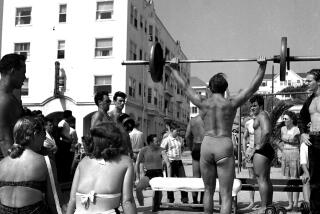Exercise Can Help Cure What Ails You
- Share via
As a young woman, Nancy had been extremely active. Fit and lean, she danced almost every night. Then she got married and had children, and her activity level ground to a virtual halt. It wasn’t too many years before her body began to be plagued by nagging aches and pains, the kind that made her feel, well, old--too old and too achy to exercise strenuously. Or so she thought.
When a friend recommended water aerobics, Nancy began attending classes in which people like her performed exercises that, on land, would have been too painful to her joints; in the weightlessness of water, however, she was able to get a workout that felt like old times. This reconnected her to the joy of movement and physical exertion. And with her devotion kindled, Nancy soon became a water aerobics instructor whose life now is as vibrant as she is.
Millions of people, I would guess, use physical ailments as an excuse not to exercise: Their knees hurt too much to run; their shoulders won’t allow them to swim; their back prevents them from riding a bike, etc. But as more and more research is conducted, more and more evidence points to the fact that certain forms of exercise are tailor-made for certain maladies and actually improve those conditions. Rather than being excuses to avoid exercise, aches and pains and even diseases can truly be reasons to get out there and do it.
Take arthritis, a disease that afflicts millions. Researchers have now established that sufferers of osteoarthritis can actually reduce the disease’s severity through exercises that avoid a high impact on the joints. While that eliminates such activities as running and racquetball, it most certainly embraces a whole world of gentle exercises like water aerobics, yoga, walking and stretching. What’s more, researchers also concluded that weight training can restore strength and flexibility to joints that the disease has weakened to the point of deterioration.
For those already suffering from osteoporosis, as well as those wanting to prevent its onset, weight-bearing exercises (any activity in which your bones support your weight, like jogging and walking, not swimming and biking) not only increase bone density, but also help to improve balance, leading to fewer falls that often produce broken bones. Here, too, strength training is essential.
Diabetes patients (type 1 or type 2) can lower their secondary risk for cardiovascular problems by doing aerobics--anything that significantly raises their heart rate--at least three times a week for a minimum of 20 minutes. These exercises will also increase blood flow to the extremities, improving circulatory problems that often end up crippling many diabetics.
People who suffer from depression have a terribly difficult time getting out there to do anything, including exercise, but the latest research shows a direct correlation between weight training and improved mood. This is particularly interesting in that there’s also a correlation between depression and low bone density--which weight-training helps to improve. Group activities like golf and tennis may also be helpful by promoting social interaction.
I would hope that, by this time, most everyone understands how aerobic exercise helps those suffering from cardiovascular disease and helps to prevent it in the first place. But, in fact, exercise helps to prevent all of the above diseases, as well as many not mentioned. The point is that regular exercise, while maybe not a cure-all for everything, is about as close to a panacea as we’ve got.
So what form of exercise should you choose? (This is probably the question people ask me more than any other.)
My best answer: any exercise that you’ll actually do.
Sure, there are certain differences between activities, with one burning slightly more calories than another. Sports like racquetball and tennis burn up to 450 calories an hour, while walking briskly consumes about 400. But really, what’s 50 calories? Just a few M&Ms.;
And if you dislike racquet sports, you’ll probably be disinclined to play, whereas if you love walking, you’re likely to get out there every day.
In my book, 85% of something is far better than 100% of nothing. Latching on to an activity (or activities) that you love will serve you far, far better than all the Olympic training regimes that you can’t stomach--and, as a result, don’t do.
Just ask Nancy. If you can get her out of the water.
*
Copyright 1998 by Kathy Smith
* Kathy Smith’s fitness column appears weekly in Health. Reader questions are welcome and can be sent to Kathy Smith, Health, Los Angeles Times, Times Mirror Square, Los Angeles, CA 90053. If your question is selected, you will receive a free copy of her book “Getting Better All the Time.” Please include your name, address and a daytime phone number with your question.





